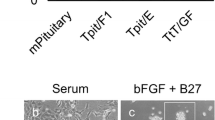Abstract
To investigate a possible neurotropic role for thyrotropin-releasing hormone (TRH) in the central nervous system, we used recombinant antisense TRH adenovirus (TRHav) to “knock out” TRH in cultured 17-d fetal rat diencephalon. The morphology along with β-galactosidase (β-gal) enzyme histochemistry (X-gal staining) and TRH content (femtomoles/well) were used to measure the effect of antisense TRH virus. Control adenovirus mediated β-gal transfection efficiency was nearly 85%, as shown by positive X-gal staining, and was without effect on cell morphology, TRH content, or the normal response to glucocorticoid (dexamethasone) exposure with enhanced TRH expression. A significant 90% decline in TRH content as well as changes in neuronal morphology (shrunken cell bodies and short dendrites) were observed after 14 but not 7 d following TRHav treatment. The addition of synthetic TRH peptide at 2.5 μM along with TRHav, but not dexamethasone, partly prevented the morphologic changes. No morphologic changes were seen in wild-type AtT20 cells, a pituitary cell line that does not produce TRH. To investigate whether neuronal death from loss of pro TRH was owing to apoptosis, neuronal DNA change by means of fluorescent dye H-33342 staining, TUNEL staining, and DNA laddering analysis was examined. Eighty to 90% positive H-33342 and TUNEL staining as well as a 180- to 200-bp DNA fragment on DNA laddering analysis were found as compared to control. These results indicate that proTRH gene expression prevents neuronal apoptosis and may play a role in neuronal development and function.
Similar content being viewed by others
References
Bowen, I. D., Bowen, S. M., and Jones, A. H. (1998). Mitosis and apoptosis: matters of life and death, 1st ed.). Chapman & Hall: London.
Gregory C. D. (1995). Apoptosis and the immune response. Wiley-Liss: New York.
Lockshin, R. A., Zakeri, Z., and Tilly, J. L. (1998). When cells die: a comprehensive evaluation of apoptosis and programmed cell death. Wiley-Liss: New York.
Lavin, M. and Watters, D. (1999). Signaling pathways in apoptosis. Harwood Academic: Amsterdam.
O'Kusky, J. R., Nasir, J., Cicchetti, F., Parent, A., and Hayden, M. R. (1999). Brain Res. 818, 468–479.
Lechan, R. M., Snapper, S. B., and Jackson, I. M. (1983). Neurosci. Lett. 43, 61–65.
Heuer, H., Schafer, M. K., and Bauer, K. (1999). Acta. Med. Austriaca 26, 119–122.
Ladram, A., Bulant, M., Montagne, J. J., and Nicolas, P. (1994). Biochem. Biophys. Res. Commun. 200, 958–965.
Takeuchi, Y., Miyanomae Y., Komatsu, H., Oomizono, Y., Nishimura, D., Okano, A. S., Nishiki, T., and Sawada, T. (1994). J. Child Neurol. 9, 287–289.
Weiss, S. R., Clark, M., Rosen, J. B., Smith, M. A., and Post, R. M. (1995). Brain Res. Brain Res. Rev. 20, 305–325.
Luo, L. G., Lee, S. L., Lechan, R. M., and Jackson, I. M. D. (1997). 79th Annual Meeting of the Endocrine Society, Minneapolis, abstract #P1-492.
Fogo, A. B. (2000). Kidney Int. 57 (Suppl. 75), S15-S21.
Luo, L. G. and Jackson, I. M. D. (1998). Peptide 19, 1295–1302.
Luo, L. G., Mao, Q. F., and Jackson, I. M. D. (1999). Society for Neuroscience 29th Annual Meeting, Society for Neuroscience. Miami Beach, abstract #301.6.
Ivkovic, S. Polonskaia, O., Farinas, I., and Ehrlich, M. E. (1997). Neuroscience 79, 509–516.
Jackson, I. M. D. (1989). Ann. NY Acad. Sci. 553, 7–13.
Luo, L. G., Mao, Q. F., Lee, S. L., and Jackson, I. M. D. (1999). 81st Annual Meeting of The Endocrine Society, San Diego, abstract #p1-319.
Pizzi, M., Boroni, F., Benarese, M., Moraitis, C., Memo, M., and Spano, P. (1999). Eur. J. Pharmacol. 370, 133–137.
Luo, L. G., Lee, S. L., Lechan, R. M., Jian, J. H., and Jackson, I. M. D. (1998). Society for Neuroscience, 28th Annual Meeting, Los Angeles, abstract #304.11.
Luo, L. G., Bruhn, T., and Jackson, I. M. D. (1995). Endocrinology 136, 4945–4950.
Luo, L. G., Wang, S., Su, E., and Jackson, I. M. D. (1999). Brain Res. 841, 189–192.
Lee, S. L., Stewart, K., and Goodman, R. H. (1988). J. Biol. Chem. 263, 16,604–16,609.
Geschwind M. and Huber, G. (1997). In: Apoptosis techniques and protocols. Poirier, J. (ed.). Humana: Totowa, NJ.
Author information
Authors and Affiliations
Corresponding author
Rights and permissions
About this article
Cite this article
Luo, LG., Lee, S.L., Lechan, R.M. et al. Effect of prepro TRH antisense on thyrotropin-releasing hormone synthesis and viability of cultured rat diencephalic neurons. Endocr 15, 79–85 (2001). https://doi.org/10.1385/ENDO:15:1:079
Received:
Revised:
Accepted:
Issue Date:
DOI: https://doi.org/10.1385/ENDO:15:1:079




